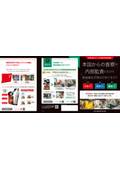This explains the key points for designing a labor safety and health management system according to ISO45001 in an easy-to-understand manner. Free materials are also available!
If you would like to know more about the attached materials, please feel free to contact us. We will introduce ideas for environmental and operational improvements.
Inquire About This Product
basic information
0. The organization's approach to continuous improvement 1. Let's consider initiatives that suit the organization - Five points for planning an OSHMS - Clarify the objectives of the OSHMS - Identify external and internal challenges - Consider the needs and expectations of workers and other stakeholders - Reflect on past safety and health plans and initiatives - Consider the scope of the OSHMS 2. Key points of the OSHMS in ISO 45001
Price information
Please feel free to contact us.
Delivery Time
※Please feel free to contact us.
Applications/Examples of results
Our staff will provide a clear explanation of the key points of ISO 45001, aimed at improving the workplace environment and ensuring the safety and protection of workers. We also offer free support such as leak prevention training and on-site surveys!
catalog(4)
Download All Catalogs![Explaining the key points for designing an ISO45001 Occupational Health and Safety Management System [*Free white paper available*]](https://image.mono.ipros.com/public/catalog/image_generated/01/b9f/446151/20181220104025_IPROS12569409178318477650_1.jpg?w=120&h=170)
News about this product(6)
Company information
Since our founding, we have been importing and selling various products, including oil and liquid absorbents, with the desire to "provide products that contribute to the improvement of the working environment and the enhancement of health and safety." For many years, we have played a pioneering role in promoting the importance of "environmental improvement and health and safety" in the industrial sector through educational activities for those working on-site. Currently, our products are used not only in the industrial sector but also by customers in various industries, including supermarkets, restaurants, schools and research facilities, and government agencies.











![[ISO Certification] ISO 45001 Occupational Health and Safety Management System](https://image.mono.ipros.com/public/product/image/6b1/2000542024/IPROS98518250653307056971.jpeg?w=280&h=280)





